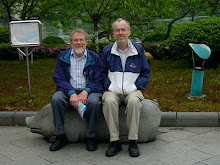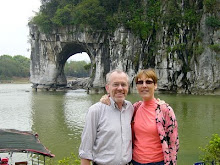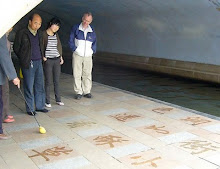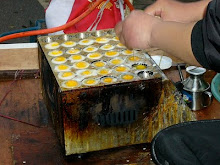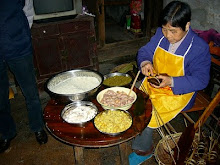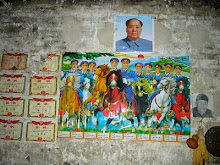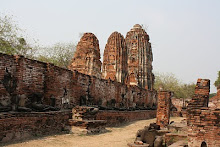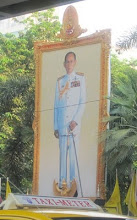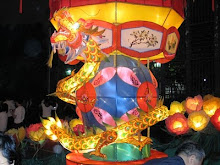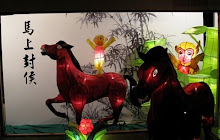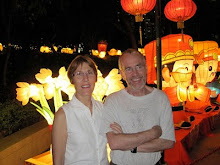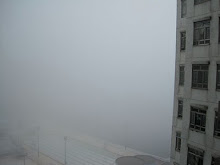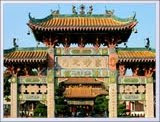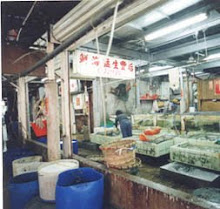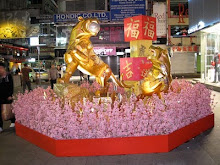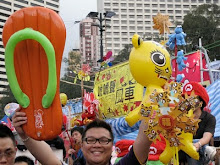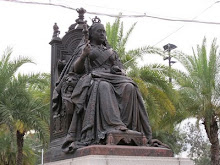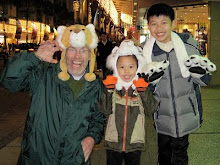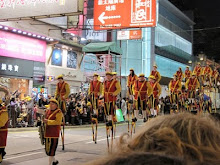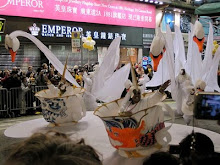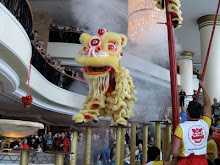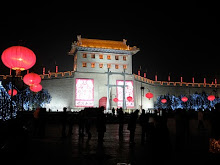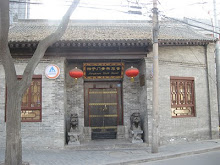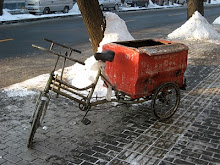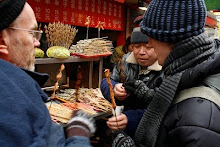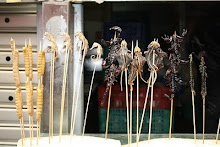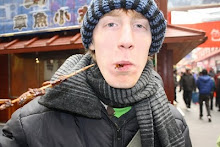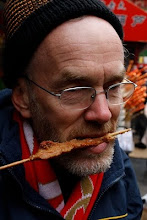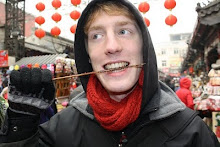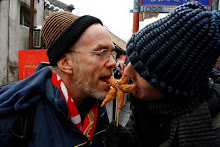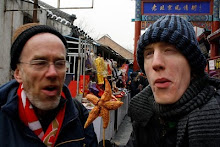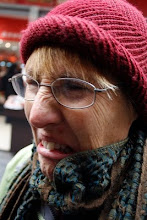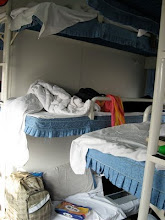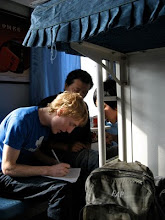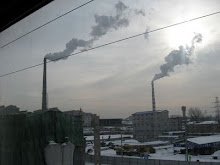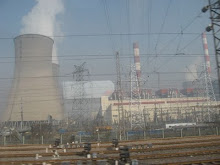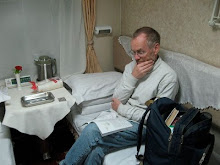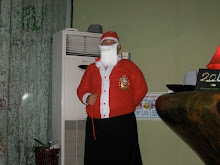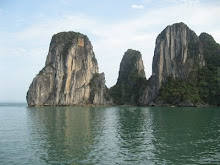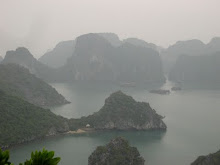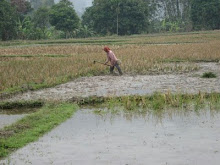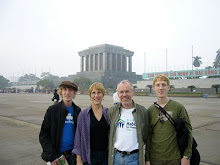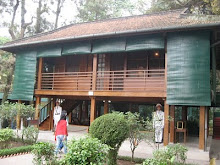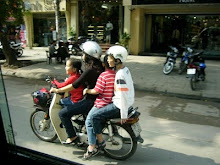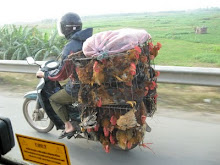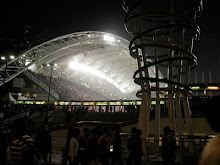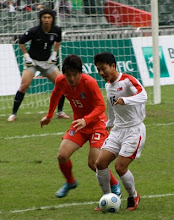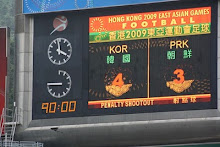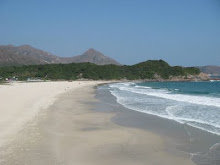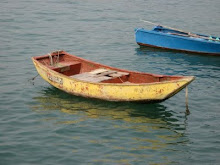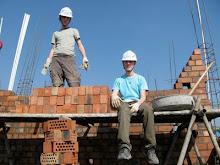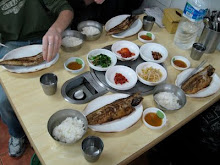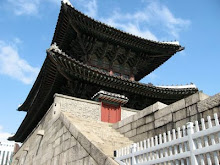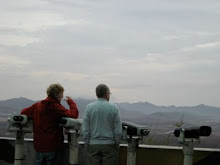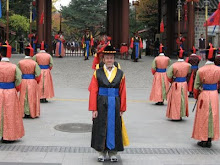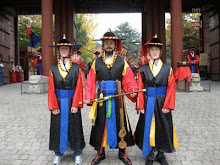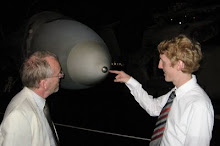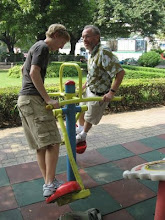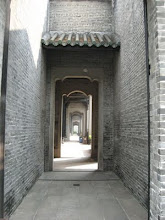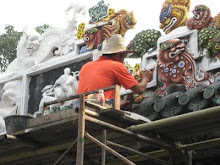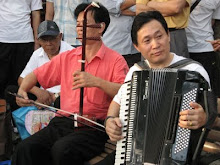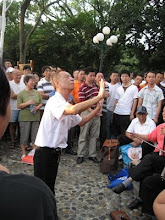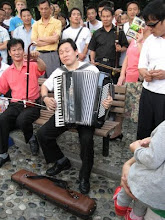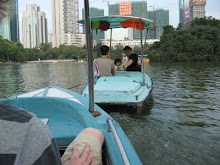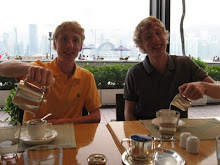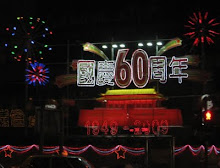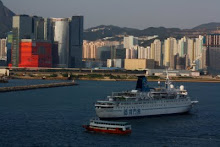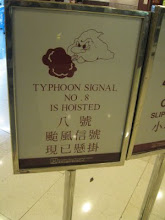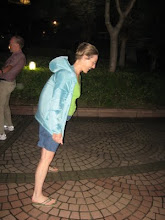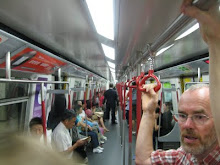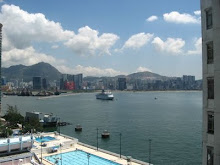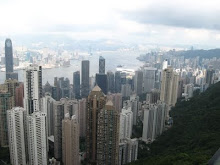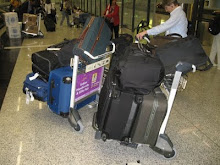Thursday, December 31, 2009
Did it do any good? Hard to say, because he was not that sick and would have got better anyway. Pak's point of view was interesting. He said that experiencing the bitterness was part of the cure. It was part of the price to be paid to get the benefit of health.
Elizabeth enjoyed the football at the East Asian Games- sort of - though we were there for about 5.5 hours which was a little much. So the following, we went to a different marathon activity, Cantonese Opera. Elizabeth's exercise class teacher was performing. There were nine sets of two performers, one playing the female and the other the male role, although they were often both women. The female role was sung in falsetto, which meant it was really high. Each pair only sung one song, but each song lasted about half an hour, so you can do the maths. Everything was in Cantonese, so we had no idea what was going on. Good live music, with a mixture of Western and Chinese instruments, but overall something of an endurance test. The performers are supposed to be singing for the gods, which is just as well as the audience didn't seem to be paying too much attention. Actually, sometimes they were, but at other times they would be having loud conversations with each other or falling asleep. It was an older crowd. We were the only white folk there and also part of the few who were under 60.
I took a break at one point and wandered round the neighborhood in search of some flowers to give to Elizabeth's teacher. They were easily found and more interesting was the scene at the local office of the Hong Kong Jockey Club. It was mobbed, with lots of people spilling into the neighboring plaza, where they were sitting around, perusing the racing paper and often smoking cigarettes. Mostly male, but not entirely so. I think I wrote about going to the races a couple of months back. This is the off- track part of the experience. It looked like the Hong Kong counterpart of a familiar working class British tradition. However, here, the Jockey Club has the monopoly on betting (or legal betting, I should say), so the shops are fewer and the crowds at them larger.
Tuesday, December 15, 2009
We also saw Guam compete in both men and women's Rugby Seven's. Apparently, the biggest sporting event of the year here is the Hong Kong Rugby Sevens, when the best players in the world compete. That wasn't happening here, because, in contrast to table tennis, East Asia is not noted for its rugby prowess. However, they do take it pretty seriously. For those that don't know, Rugby Sevens is a version of the game where each team has 7 players on the field and each half lasts for 7 minutes, with a running clock. The idea is to make the game go very fast and it works that way. It has been added to the next Olympics and so the IOC commissioner was here to give out the medals to denote that fact. Getting creamed at Rugby Sevens looked distinctly more painful than at table tennis. The biggest discrepancies appeared to be with the women, where the Hong Kong and the Guam teams looked like high school girls, in comparison to the much larger and stronger Chinese women. In the first game I saw, the Chinese women beat Hong Kong by 44 - 0. That is a lot of points to score in 14 minutes.
The men's games were more competitive, and in fact Hong Kong heroically beat China to get to the gold medal game against Japan. They almost won that too, but Japan overtook them on the very last play of the game. In Rugby Sevens, the game can only end on a dead ball and since that does not happen very often can get extended beyond those 7 minutes. I get the sense that Hong Kongers have absorbed some of that British plucky losers spirit, so almost winning may feel more comfortable. The Guam teams endeared themselves to everybody after their losses by performing a short excerpt from Michael Jackson's Thriller on their way off the field.
The football was spread out over the duration of the games and we just saw the 3rd/4th playoff for bronze and the gold medal game. And unlike the rugby, only men were competing. The bronze medal game was interesting because it was North vs South Korea. Who knows what was going on in their heads, but they were very nice to each other on the field. Playing hard, but the fouls were fairly benign and they helped each other up after them. The north team looked a little older and a little tougher, but the game ended up as a 1:1 draw. The south prevailed on penalties. One remarkable thing about that (for all you soccer/football aficionados out there) was that the referee had a N Korean player take his kick 3 times. The first 2 attempts were both saved, but the ref said the goalie moved too soon. The goalie got really mad and ended up getting a yellow card for his pains. But he went ahead and saved for a third time, which meant that S Korea had won the game.
On to the final, Hong Kong vs Japan. HK were expected to be the plucky losers once more, but this time they won, again on penalties, much to the delight of the large and raucous crowd. We were sitting right next to the core of the HK support, who came equipped with drums and an enormous flag - probably about 20 x 30 feet. That flag did a complete circuit of the stadium, being dragged across the tops of the crowd's heads. It was interesting to see the enthusiasm with which the HK fans booed the opposing team - seemed a little unAsian somehow. The Japanese scored half way through the first half. But then HK brought on their super sub at the beginning of the second half. He is actually part of the British Premier League's Tottenham side and they allowed him to come home for this game. He only arrived a couple of hours before the game and scored with a nice header about a minute into the half. That was all the scoring, despite extra time and so to the penalties.
Wednesday, December 2, 2009
Korea was followed relatively quickly with a trip to Zhuhai. Zhuhai is to Macau what Shenzhen is to Hong Kong, i.e. a city just adjacent to a Special Administrative Region, where economic incentives facilitate rapid growth. However, Macau is not Hong Kong and so Zhuhai has not developed to the same extent as Shenzhen. Maybe at least in part because of that, the PRC government is trying to make it into a center for higher education, establishing branch campuses for several universities. Hence United International College, which bizarrely is a partnership between Honk Kong Baptist University and Beijing Normal University. Christianity and communism combined! However, the HKBU part is dominant and really all that BNU does is to enable HKBU to set up shop in mainland China.
We were at UIC to help with a liberal studies conference/workshop that also involved a number of people from a consortium of Minnesotan Private Colleges. I was particularly impressed with the President of Saint Scholastica in Duluth, who gave a couple of talks with excellent and thought-provoking content.
It was a much more Chinese environment than the more international Hong Kong. Such things are most noticeable for me when it comes to breakfast. Any number of savory dishes - congee (savory rice porridge), noodles, steamed buns of various types, meat and vegetable dishes. One evening we went into town, but UIC provided us with student guides, to take account of language issues and to make sure we did not get lost. Elizabeth and I had a great time with our guide, who unusually was from Hong Kong. We spent the whole evening in a hot pot restaurant, which meant we were given pots of broth, heating on burners at the table, in which we cooked all manner of good stuff.
The provost at UIC has the goal of extending the work we are doing with general and liberal education in Hong Kong to mainland China. Talk about thinking big. Rather overwhelming if you ask me.
So that was a 3-day trip and since then I have helped with workshops at the HK Institute of Education and the HK University of Science and Technology. Plus things have been heating up at PolyU, since I have figured out how to engage with the parts of the university required for me to be effective. In addition I have been working with the General Education Centre here as it plans the transition to a normal academic department. Then the semester is ending so I have had all the usual end of semester stuff with my class.
However, there has still been time for fun stuff, not that the work stuff has not also been fun. There was Thanksgiving in there somewhere, when the Freake/Huebner family cooked. Lacking an oven, we could not host, so we decamped for the afternoon to another Fulbrighter's much larger apartment. Just the afternoon, mind you, because I had to teach in the morning. And the turkey cost the usual weekly food budget.
This past weekend, we had two wonderful outings. The first was to Sai Kung Country Park. It required a 90 minute ferry ride and then close to an hour trek, to get to some fabulous beaches. These beaches came equipped with cafes, which suited me, and big waves, which the surfers enjoyed. Then yesterday we went to one of the HK islands called Cheung Chau. It was just like putting down into a Chinese version of a Mediterranean village. A little bigger and more crowded but a wonderful place to be. You can buy fish in the market and take it to the restaurants to be cooked. And just half an hour by the fast ferry from downtown HK. Not a bad place to live!
By the way, I am not sure what photos I am going to put up with this narrative. My designated photographers, Jacob and Duncan were off in Sichuan on the Habitat for Humanity. They had a wonderful time there and are now adept bricklayers.
Sunday, November 15, 2009
So that was the work, and then there was exploring Korea. The first remarkable thing was that it was autumn or fall. Their was a nip in the air and there were trees whose leaves were changing colors and falling to the ground. Not very remarkable you might be thinking, but in Hong Kong terms it certainly is. There are temperature variations here, but not really the four seasons that we know and love in the northeast USA. So oohing and aahing over the spectacular colors (largely Japanese maples - or are they Korean maples?) and swishing our feet through piles of leaves was delightful. I hadn't thought about missing fall at all until I saw it again.
I think Korea is not nearly as well known in the USA as is Japan and China. In fact it is a very old and vibrant culture. Seoul is enormous, but much more spread out and not as vertical as Hong Kong. A slower pace, I think. The four of us stayed in a suite in a hotel that was very close in size to the apartment we live in. The kitchen was a noticeable upgrade, with a dishwasher, very modern clothes washer/dryer and, best of all, an oven! Surprisingly, we never got around to baking anything.
They have done a pretty good job of preserving some old palaces in Seoul, despite occasional fires and invasions.. We went to the largest and best preserved one Chankdeokgung. We were only allowed in as part of a group with a guide, but since the guide was good and the cost was minimal, that was just fine. Beautiful buildings of brick and stone and wood, reminiscent of those we had seen in Guangzhou. In fact, my Chinese colleague Pak told me that they were Chinese in design, but sadly, from his point of view, most Chinese palaces like that had been destroyed.
Another interesting place we visited was the DMZ (demilitarized zone). That had been on the top of Jacob and Duncan's list ever since we had been told about this place frozen in time that was now an ecological treasure. Not that you can get in to see the treasure, the DMZ itself is like that because humans don't go in there. But it is the most popular tourist destination in Korea, at least among foreigners. I think fewer Koreans go there. Our bus group had people from about 10 different countries, with most continents, with the exception of Africa, represented. It was a gray and rainy day, at least on the way up there. That seemed appropriate - I was sort of thinking of it as trip to Mordor. We saw the Freedom Bridge, an observation post and then went down into one of the several invasion tunnels that had been dug in an attempt to invade the south.. On the one hand it seemed a little like an amusement park (they do have rides by the Freedom Bridge). On the other, there were soldiers there ready to delete all the photos on your camera if you took forbidden pictures. In fact, the day after we were there, there was a skirmish between the two navies, which resulted in one sailor being killed.
Older Koreans would like to see the country reunited. In fact they built a beautiful new train station that currently sits unused, waiting for the border to reopen and trains to run north again. But the border is over 50 years old, and for younger Koreans, reunification is rather abstract and may not be a good idea.
Well there is much more I could write about, the markets, the food, the outdoor sculptures, but I think I'll stop here and leave you to wonder what on earth we were getting up to in those cool costumes!
Tuesday, November 3, 2009
We arrived at Fenwick Pier, the little bit of Hong Kong Island reserved for the US Navy, to get the water taxis out to the ship. Since it is nuclear powered, it was not allowed into Victoria Harbor and so we had a 40 minute ride out to it. Aircraft carriers are big, especially when you come upon them in a small boat. (How do those Somali pirates do it?) We boarded via a floating dock moored to the stern of the ship. We went up a couple of decks to find the welcoming party - two rows of sailors, both genders, all saluting that funneled us in to shake hands with the captain. We turned the corner to enter a big hanger area, where there was another more inanimate gauntlet consisting of flags of the 50 states. Plus the odd helicopter and fighter jet. A friendly woman from the US embassy volunteered to take our picture in front of the helicopter.
We entered an adjacent, even larger hanger area with even more F18s, where most of the reception was held. I'd guess about 500 people, including sailors were there. Very meaty food and lots of beer, though not, at least initially for the sailors. No chairs. I liked talking to the sailors to find out a little about their lives. One of them was an armaments technician - it was his job to maintain all the bombs and rockets that go onto an F18. Jacob and Duncan got into all sorts of technical conversations about nuclear reactors and such things. There were a few but not many speeches and then came the highlight of the evening. We got to ride on this enormous platform elevator that is used to bring aircraft to and from the flight deck. I guess they need to move them quickly, because this one elicited fairground-like gasps from the passengers as it took off upwards. I liked being on the flight deck - big open space, with lots of planes, and of course the Hong Kong skyline as a backdrop. More F18s but then other surveillance and communication planes too that had all sorts of weird bits sticking out.
Five thousand people live on the George Washington. It's a small city, powered by two nuclear reactors and home to who knows how many aircraft. Your tax dollars at work, though I, for one, might vote to spend them on something else. I did enjoy the party, though, and fortunately Jacob and Duncan avoided taking the King's shilling.
Tuesday, October 27, 2009
Guangzhou is better known in the west as Canton and so, unlike Shenzhen (last week’s Chinese sortie) is very old. It is old with respect to Chinese culture (as in 1000s of years) and also in terms of interactions with the west as a center for trade. A few weeks back we went to an art exhibit at the Hong Kong Museum of Art that was laid out as a travel guide to Canton, not to be used after 1850. Lots of paintings and drawings showing what the average Victorian tourist might see and do there. I believe that Guangzhou is now the third largest city in China and so it has lasted well and prospered.
English is understood and spoken only to a very limited extent. But a little pantomime goes a long way and we did not really have any problems. The hotel had little cards on which we would get them to write the names of places we wanted to go for taxi drivers. Plus we had a pretty good map that we could use to negotiate destinations. We also used the subway, though for the 4 of us, taxis came out to be the same price with greater flexibility.
Lack of being able to speak Cantonese or Mandarin to any significant extent led to interesting food experiences. Lunch 1 right after we arrived had to be close to the hotel since we were hungry. We went of the Hunan based on the fact that it was on the 6th floor and any restaurant that survives there has got to be good. The menu had very good pictures. We did not appreciate that Hunan = spicy and so unlike last week when we negotiated around one very spicy dish in Shenzhen, here they were all like that. But that tasted very good, particularly the fried eggplant and the river shrimp. Dinner ended up being Middle Eastern, for reasons also related to language, but that I won’t go into. One of the managers befriended us. He was from Jordan and insisted on going around the very extensive buffet and explaining each dish to us. Everything was very good, but also quite expensive by local standards and so we felt obliged to overeat. The next day we were in a market at lunchtime, so we just randomly selected a busy market café. There did not seem to be any menus, but the food on other people’s plates looked good and then it turned out that one of these people spoke some English. We ended up getting 4 plates of what she had (fried noodles – they were excellent, especially with a little chili sauce and fresh cilantro added) and 4 oranges sodas (because they were cold and presumably microbiologically sound). The whole meal cost 28 yuan for the 4 of us – which amounts to about US$4.50. You could spend the same amount, well actually more, on a tall latte at one of the several Starbucks, also to be found in Guangzhou. I guess we are one of the few bizarre people who frequent both kinds of establishment.
But the high point of Guangzhou for me was the Chen Ancestral home. A beautiful, very well preserved collection of buildings, about 150 years old. The decorative carvings were magnificent, either in stone, brick, wood or plaster. The whole thing was very nicely laid out and also housed a folk art museum. The museum had just about the most spectacular embroideries I have ever seen, very realistic landscapes, but with the sheen of the thread giving a texture you would not see in other mediums. There were also wonderful multiple-layered ivory carvings – I have no idea how they are done. We also had chops made. This was my solution to the problem of not being able to write my Chinese name. A chop is a stamp, in this case made out of soft stone, so now my Chinese illiteracy can be concealed. The chop carving was followed by an extended bout of tea tasting. All in all, a wonderful place to visit.
Tuesday, October 20, 2009
It is right across the border from Hong Kong. In fact we got there by taking the MTR (metro) to the end of the line and then walking across into China. We were accompanied by 1000's of other people - it is also apparently one of the most traveled crossing points in the world. Of course, it is not really a border, because both sides are in the same country, but we certainly went through two sets of immigration controls. It took time but it was straightforward.
Many people (both local and expatriates) warned us to beware of pickpockets in Shenzhen. Many people go up there to shop because prices are cheaper than Hong Kong. There is a giant mall just across the border and countless men soliciting the wealthy looking visitors to come and buy whatever. I am not a shopper at the best of times (except for food) and we just kept walking until we had passed through that area.
Our first stop was a store selling CDs and DVDs. The DVDs included those released last week and they all cost 20 yuan, which is about $3. Duncan decided he had to try one out. The quality was pretty mediocre for both sound and video, but the packaging was very impressive. We next went into a mall because it seemed to be advertizing tea. Unlike Hong Kong, few signs are in English. It contained the largest collection of stores selling tea and tea ware that I have ever seen. Outside, each store somebody would be sitting picking over the teas, separating the leaves from the twigs. They would invite us in to drink some tea, in the hope that we would buy. Other stores sold teapots and others still tea trays. This is different from a British tea tray, in that Chinese tea ceremonies involve lots of spillage and so your tray needs to be able to collect all that liquid. The ones that I had seen before were all made of wood or bamboo, but here there were beautiful ones made from stone, with extensive carving. They weighed a ton, but we are plotting how one might find its way back to Connecticut. For the time being we resisted all purchases and moved on.
Our target was the tallest building in Shenzhen because we heard that you could get to its top. We found it and discovered that the top was advertized as the first theme park in Asia at the top of a skyscraper. We paid our money and went up to discover spectacular views and a tacky theme park, which I suppose is what I expected. From the top, we could see a park nearby with a lake and boats for rent. We decided first lunch and then a boat ride.
Lunch was a little hard to find, which it never is in Hong Kong. But eventually we found a likely looking spot, went in and pointed to what we wanted on the menu (which fortunately had good pictures). There was one person there who spoke a little English and she warned us that the fish soup we ordered was hot. When it came, we discovered she had spoken the truth. An interesting in-your-face heat, very raw and irritating to the throat. But very flavorful too. The rest of the food was more moderate (and therefore typically Cantonese). The other interesting things about that restaurant were the large jars of picked snakes. I tried to find out more about them but the English speaker had by that time left.
So off to the park, where the first exciting thing was the grass. There is so little of it in our part of Hong Kong. We rented our boat, which had a small electric motor and seemed to go slower than all of the others. After a little while, our motor gave up entirely. Fortunately, our plight was apparent without language and another boat towed us back to the dock.
But while we were out on the lake, we heard music, so when back on dry land we went to investigate. Tucked away in the woods, we came across several groups of people who had just come together to play music. The first group we listened to had an accordion player and then two people playing the erhu, a simple two stringed instrument played with a bow. They were wonderful and pretty soon were joined by people who knew the words to the songs they were playing. They joined in as equal partners, not just singing along quietly in the background, but really giving it their all. Then another man came along who decided to be the conductor. The whole group of them was so passionate and completely involved in their music it was spellbinding. There was another group playing Chinese jazz (four saxes, guitar, flute and some kind of horn) and then just a solo sax player with vocalist. Then there were the feather hacky sacs, the badminton games, the dancers and martial artists etc. etc. I loved it all. If only that went on in our local parks in the USA ...
Monday, October 12, 2009
In a nutshell, Hong Kong has decided to transform its education system by lopping a year off high school and adding a year onto university, changing the latter from three to four years. Another way to look at it would be to say they are switching from a British to a US program. I had assumed that switch reflected the world's realpolitik. It seems that the US has as much influence in Hong Kong now as the UK. And then of course, the major influence on Hong Kong, i.e. the country of which it is a part, China, sends its students to college for four years.
It turns out that the decision was a little more rationally based. Hong Kong students have always scored very well on tests of quantitative ability; in fact they put the US to shame. In addition, in the international survey of universities published by the Times Higher Education Supplement last week, Hong Kong placed 5 in the top 200, led by Hong Kong University at #24. Even my institution, Hong Kong Polytechnic University, squeaked in at #195. UConn did not make the list. These league tables are always a little peculiar, with a large component based on subjective assessments, I think in this case of college presidents. However despite this rosy picture, when local employers were surveyed, they said that they would much rather hire graduates of US or European universities than those from Hong Kong institutions. Although Hong Kong graduates knew a lot, their ability to think critically and creatively and adapt to changing situations was limited. Since the opinions of local employers are very important in this capital of commerce, these surveys were taken very seriously, hence the wholesale changes that are now being undertaken.
Universities here are increasing their curriculum by one third. They have also been encouraged to do so not simply by adding a year at the beginning, but rather to rethink the entire undergraduate programs. Of course, the extent to which they are truly doing this is questionable, but that is the idea. It is an enormous, courageous and exciting undertaking. It would never happen in the US, where the system is too big and too decentralized. But here there are 8 publicly funded universities and so such changes can be mandated.
After the changes were announced, a Hong Kong businessman by the name of Po Chung got involved. He had attended college in the US and developed a very high regard for the idea and practice of a liberal education. He saw the reforms as a wonderful opportunity to get Hong Kong students to think more broadly and creatively. Together with the Hong Kong America Center, which administers the Fulbright programs here, he came up with the idea of bringing 20 US scholars who had worked extensively with GenEd programs to Hong Kong over a period of 4 years to help with the changes and try to ensure the programs developed were as strong as possible. He gave US$1M, matched here in Hong Kong to make it happen.
So here I am, slowly figuring out the workings of PolyU and the other institutions of higher education and determining what makes sense. More on
Monday, October 5, 2009
The build up to the 60th anniversary has been quite pervasive and long lasting. We have been aware of it since we arrived here, with lots of posters, neon displays, artistic performances etc., etc. It all came to a head on the day itself, Thursday October 1st. That day marked the beginning of an unprecedented 8 day holiday on the Mainland (though not in Hong Kong), which conveniently included the Mid-Autumn Festival. Thursday was a public holiday in Hong Kong. I don't know how people treat public holidays here, but as far as I could tell for the most part it seemed like a good reason for not going to work. I decided to take my parade watching semi-seriously, although since it was in Beijing that meant sitting in front of the TV. As anybody who watched the last Olympics knows, the Chinese know how to run a parade. This one was divided into two parts, the military and the cultural. I found both surprisingly interesting. The soldiers, for example, were selected for being in the parade on the basis of height. They were all the same, being between 1.8 and 1.9 m, I think. That makes it look very good, because you see an array of soldiers, aligned in perfect rows and columns, all the same height. It is a 3-dimensional masterpiece! We were wondering if some of them were wearing lifts in their shoes to make up for small differences in height. And then they drill those soldiers to such an extent that all movement is perfectly synchronized. Actually, that part goes for the cultural portion of the parade as well - they must spend a phenomenal amount of time practicing. I did not pay too much attention to the military hardware although there was a lot of it.
The cultural part of the parade was much more colorful. As a backdrop, Tienemann Square was filled with people who were holding up, probably colored cloth, so that all you see is a sea of color. But the sea has Chinese characters in it that are spelling out something. Then, almost instantaneously, the colors of the background and the characters change to spell out something new. My conclusion was that each unit of space was occupied by two people, one standing and visible and the other crouching and hidden. At set times they would swap positions, to make the color changes. In front of this backdrop they had a very impressive parade. We are already planning for the boombox parade in Willimantic next year. Do you know that China has only had 4 presidents in the past 60 years. They tend to be long-lasting. Each was represented by a large painting drawn on a float surrounded by colorful dancers.
I could go on, but I won't except to say that the commentary was very interesting. The Hong Kong TV station took the direct feed from China, complete with audio. It was totally gushing, I guess like the Macy's Thanksgiving Day parade, except that it does come across a little differently when it is tanks rather than an inflatable Snoopy going past. But then the Beijing commentary was regularly interspersed with that from the Hong Kong station, which, while not being overtly critical, was certainly questioning. This Hong Kong attitude towards the mainland is well illustrated by the coverage in the South China Morning Post. They devoted a lot of space to the anniversary, with diverse perspectives represented. There was a table of 60th anniversary events in Hong Kong that included all the official stuff, but then just as many, if not more, protest activities focused on human rights - marches, candle-lit vigils and so on. Another time I will have to write about Hong Kong attitudes towards mainland China/ the UK/ the USA and so on. These things are complex here.
The Mid Autumn Festival seems to me a lot more straightforward, although it is very old and has some connection with liberation from the Mongols. But everybody decorates with paper lanterns and gives their neighbors mooncakes. These are baked confections that come in many flavors; disc shaped and filled with locust bean paste and egg yolks. I would not rate them at the top of my list of desirable pastries, but people here are very attached to them. Then at night, the big thing is to go out and greet the harvest moon. The children take their lanterns with candles when they do so and get up to interesting tricks with the hot wax. I did not get to see that myself, because we had spent the day hiking on Lamma Island and were pretty exhausted by the heat. More of that another time.
Monday, September 28, 2009
People
There are a lot of people in Hong Kong. They are not quiet people either and so Hong Kong is also a noisy place. Both aspects are in stark contrast to our usual life in rural Connecticut. Both are in many ways refreshing but I can imagine there will come a time when I crave for peace and quiet.
I walk to work everyday and vary my routes for interest and to discover as much as possible in the side streets of our neighborhood. Street life is so complex that there are often new things to be seen, even on streets that I have walked on many times before. The other day I was with Jacob and he noticed a movie theater that I had never seen before. (I have been talking with a colleague in the General Education Centre who is a film critic and he has promised to get me into Hong Kong Movies beyond Bruce Lee and Jackie Chan.) But the last half of my walk to work is along a walkway. It is about 20 feet wide, sometimes elevated above the roads and sometimes a tunnel, going under/over who knows what. It always appears to be crowded with people, going in both directions. Some of them are students/staff going to/from PolyU, but that probably represents a minority. The numbers are swelled by the fact that the walkway also connects to stops for buses that go through the tunnel to Hong Kong Island. But for the most part the destinations and purposes of all these people is unknown to me. But I have ample opportunities to observe.
There is a wide variety of ages. I actually see more elderly people in the streets closer to our apartment building. Sometimes they are by themselves, shuffling along or sitting on one of the benches, watching the world go by. Sometimes they are with a younger person who is playing the role of support or guide. Normally they are female, either a daughter or granddaughter or a paid helper, usually Filipino. I am told that older people do well here (I think Hong Kong has the second longest life expectancy in the world), as long as they have family. The other interesting category of people I see before I get to the walkways is children being escorted to school. They are wearing their neat school uniforms and walking hand-in-hand with an adult. It could be father or mother or, again, a Filipino helper. It has the look of a relaxed stroll, rather than the rush that you might expect in the United States. The pace of walking or the more relaxed life in general seems to allow interactions between the two of them, conversation, jokes, physical affection.
A variety of paces can be found in the walkways. Some people are ambling along, whereas others are moving much more quickly, intent on getting somewhere. Needless to say, I am in the latter category. Surprising to me, given the variations in speed and the fact that there appear to be no rules like pass on the left, there are no collisions and almost no physical contact. People have the skills to get extremely close to each other without actually touching. There is not much space to go around in Hong Kong and so people have learned to be comfortable with small amounts of personal space. Sometimes this is manifest in interesting ways. For example, I can be in the supermarket, perhaps 2 feet from the shelves, inspecting the merchandize. Local people will think nothing of occupying the space between me and the shelves, apparently oblivious to my presence. It would be thought of as extremely rude in the United States, but here the understanding of personal space is so small that clearly there was plenty of room. This understanding allows the migration of lots of people through the walkways with efficiency and lack of trauma.
Another aspect of the people that interests me is their dress. This is a big city and so dress is important. Elizabeth notices fashion much more than I do so you should go to her poisedforlife blog for more complete descriptions. I find myself noticing clothing quite often because it seems interesting. I am not just talking about short skirts on the younger women, although that is quite evident and it is almost always the women that are interesting. It might be the tops, with either cut or color or some combination of the two being striking. Or it might be the words written on the t-shirts, making statements that are not quite right, grammatically speaking. None of the phrases have stuck in my memory, but Hong Kong is famous for these t-shirts.
Sunday, September 20, 2009
Our first typhoon
We got our first 8 on Monday, around 4.30 PM. But it was very civilized because they announced that the number 8 signal was to be hoisted then a couple of hours earlier, to give people, especially those living on the outlying islands, the chance to get home. Our flat is well positioned to view a typhoon, as it faces east/north/east. But of course, we did not want to experience it from the confines of our apartment. So we waited for a break in the rain and then went down to the waterfront. The tall buildings interact with the wind and so in some places we would wonder what all the fuss was about, whereas in others, we would be struggling to keep our footing and avoid being blown off our feet. Duncan figured out that that pleasurable sensation could be enhanced if he held his jacket out with his arms to create sails. Given that the walkway was made of bricks that became slippery when wet, he invented a new sport of typhoon windsailing. Elizabeth and I restricted ourselves to just seeing how far it was possible to lean into the wind without falling over - quite far.
That was the fun part of the typhoon. The less fun part was that the wind quite effectively forced water around the seals of the windows in our flat. We had towels placed along all the windows, but in the living room that was not enough, because the towels were soaked in 5 minutes. Jacob worked out an effective wicking system so that the water would flow through the towel and into a bucket. Then the latches on 2 of our leeward windows (one of them nicely positioned right above the head of our bed) broke. I managed to fix it closed with a metal coat hanger, so that we could get to sleep.
The wind had dropped some when we woke up but the number 8 signal was not relaxed back to a 3 until 10.30. When that happens, everybody has an hour to get to work. I saw a fair amount of tree damage, but overall the city came through very well. Any debris was cleared away remarkably quickly. There are 2 or 3 typhoons that come through every year and I realized that evacuations never seem to be a part of the plan. Everybody is expected to go home to ride out the storm. I suppose that the buildings are constructed to withstand anything that is likely to come. We could feel our 20 year old block swaying a little and the window frames were flexing back and forth. It would have been fun to be at the top of one of the really tall ones, to see how much they move.
Sunday, September 13, 2009
Then we have the MTR subway system. It is not enormous by NYC standards, but it is so much cleaner, quieter, cheaper and more pleasant, there is really no comparison. It is more like London's except enormously less expensive. Waiting for more than 5 minutes for a train seems unusual. And then they have interchange platforms, where two different lines come together, They have the timing down so well that they synchronize arrivals so that people can change from one train to the other without waiting. The exits are labeled, so that when people are giving you directions, they tell you which exit to use.
Taxis are also cheap and very plentiful, although my non-existent Cantonese means that it can sometimes be difficult to communicate the destination.
But my first love is the buses. There are literally hundreds of different routes. When I first came I asked for a bus route map, but there really isn't one - it would be too complex. So for a while, the buses were an impenetrable mystery. Then I discovered that my Hong Kong street atlas marks bus routes and since that discovery, I feel like I own the city. The double deckers are best, riding on the top deck, with so much to see. They are, of course, cheap and they go everywhere.
There are also trams, lots of them, but mostly restricted to a single line going east/west across the island. Also double deckers, but very narrow. Yesterday, we just got on them and rode from one end of the line to the other. They are very slow, but cheapest of all. It will set you back HK$2 - just over 25 cents US, to ride.
Having said all that, I walk to work every day.
Sunday, September 6, 2009
Sunday evening and we have now been in our apartment (or in Hong Kong/British parlance, flat) for almost a week. Our move-in was delayed by the need to install new air conditioners. The PolyU people, who are the official renters of the flat, are very picky and went over it with a fine tooth comb to make sure everything worked. The landlord, CY Chim is a very good man and he seems to want everything to be good for us. On the day we moved in he came and took us on a tour of the neighbourhood. The waterfront, the municipal swimming pools and soccer field, the local park, the wet market, the dry market, the public library and then all the Wonderful Worlds of Whampoa (more of those later). It was enormously helpful and saved us several days of wandering around lost by ourselves.
The closet city to Hong Kong in the USA is probably New York. Rent and property prices may be similar. As a consequence, apartments are very small by US standards. I believe ours is 750 sq. ft. Jacob and Duncan each have their own bedroom but they are each only about 10 x 6. What it lacks in square footage, it makes up for in views. Our flat is on the 12th floor (our block is small by local standards) and we look out over the harbour, which is surrounded on most if not all sides by high rises of one kind or another. So as I look out now, I see the MegaBox, a big retail/entertainment complex. It has an elaborate and constantly changing display of lights on the outside. Between us and it, are two cruise liners that are anchored in the middle of the bay. They are also lit up like Christmas trees and getting ready for their nightly trip out into the ocean. Gambling is illegal in Hong Kong (surprisingly) and so the solution is floating casinos. They go out very late and then return around 9 the next morning. I think I will give that experience a pass.
August 22, 2009
So we have been in Hong Kong for 5 days now. What a place! We are staying in the Regal Kowloon Hotel. Kowloon is a part of Hong Kong that is on the mainland. It looks at Hong Kong Island across Victoria Harbor, which has to be one of the most beautiful urban views in the world. They do architecture well here, so lots of elegant skyscrapers that are all lit up like Christmas trees at night. Kowloon is equally, if not more crowded than the island. A few less Westerners, so more Chinese. Our hotel is only 5 minutes walk from Hong Kong Polytechnic University (PolyU), where I will be working. Of course, I am not going to be living in the hotel for 10 months, so we have spent a lot of time looking for an apartment. Fortunately, people have helped us with this from PolyU, since the combination of jet lag, culture shock and complete lack of Chinese language skills would have made it impossible otherwise. But after 3 days of looking we were successful, and will move into our modest 12th floor apartment later next week.
Hong Kong is very hot and humid, very crowded, very foreign and very familiar at the same time. Multinational corporations are all over the place. There are three Starbucks within two minutes of the hotel. I haven’t been in them yet, but they seem to have that Starbuck’s feel, though the menus are different. I’ll have to see what the coffee tastes like. Also lots of Seven Elevens. But they have whole cooked chickens and all sorts of other prepared foods for sale in them.
Sunday, August 16, 2009
August 16, 2009
I am currently 6 hours into our 15 hour flight from Chicago to Hong Kong, which means that we are somewhere over the Arctic Ocean. Who would have thought that you would fly north to get from Chicago to Hong Kong!
We had an interesting departure from Bradley Airport this morning. We stayed at the Sheraton Hotel at the airport on Saturday night, so that we would be ready for our 7.15AM flight. That worked well and Jacob and Duncan had a pool party for their friends last night, courtesy of the hotel. But then this morning, when we lugged our gargantuan bags to the check-in counter, the agent asked us how long we were staying in Hong Kong. Ten months was the answer. Where is your visa? I showed her. They had been sent to us courtesy of Hong Kong Polytechnic University, where I will be working. “This visa is not valid” she says. “It has to be used on or before March 11 2009”. I tell her that there must be some mistake – we had just been sent those visas, but she sent us off to another line for problem cases like us. We stood in that long and slowly moving line for a few minutes before Duncan came up with the solution. The visa says it must be used by 3-11-09. Everywhere but in the USA, they put the day before the month, so 3-11 means November 3 not March 11. I go back to the agent who is very apologetic and gives us personal service from that point on. “Your bags are all more or less under 50 pounds, right?” she says, printing out the tags. In fact they were because we had worked hard to make sure of that, but they could have been 100 pounds for all anybody knew.
The trip to Chicago was uneventful. We had to wait almost 4 hours for our flight to Hong Kong, which we boarded on time. However, then we sat on the runway for close to 2 hours as thunderstorms rolled through and then they gave priority to landing flights. But eventually we got airborne, flying north, which was a surprise. The route to Hong Kong is up over the pole and then down through Siberia, Mongolia and China.

